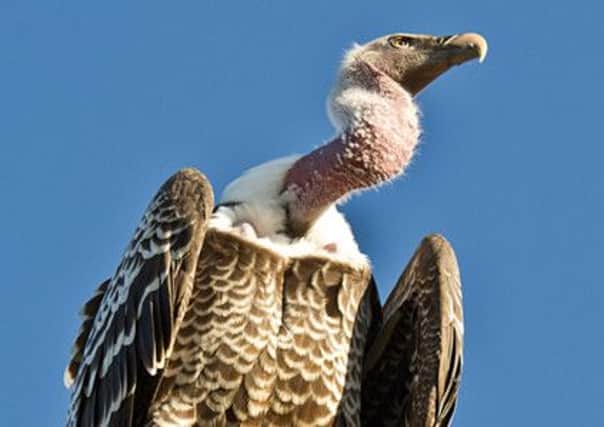Sighted but Gandalf the vulture still missing


Gandalf – with a wingspan of two-and-a-half metres – was performing for a crowd at World of Wings in Cumbernauld when it was chased off course by three buzzards and failed to return on Sunday, 23 March.
The attraction’s director David Ritchie said staff were increasingly concerned about the welfare of the Ruppell’s griffon vulture.
Advertisement
Hide AdAdvertisement
Hide AdDespite around 200 reported sightings, no-one has yet been able to locate the bird.
Mr Ritchie said: “The next few days are quite critical. Hopefully she will come out into view more now that she’s getting hungry.
“Lots of people have been in touch saying they have seen a ‘big bird’ in the sky.
“We’ve been checking these sightings out, but some have turned out to be herons while others have been buzzards. One was a peregrine falcon. We are truly grateful to everyone who is trying to help, but a lot of people do not seem to realise how big Gandalf is.
“With a wingspan of 2.5 metres, or eight-and-a-half feet, Gandalf is easily the biggest bird flying in Scotland right now.
“She is three or four times bigger than a buzzard.”
The centre’s director said the most likely sightings had been around Stirling, Falkirk, Grangemouth and near Cumbernauld itself, although reports have come from as far afield as Fort William.
In 2010, Gandalf disappeared for five days before turning up in Falkirk. Most of the current sightings of the ten-year-old bird, which is native to central Africa, were reported a day or two after the event.
Mr Ritchie said the centre needs to have a live sighting called in, as happened four years ago.
Advertisement
Hide AdAdvertisement
Hide AdA deer’s head has now been left on one hillside near some reported sightings in an attempt to lure the giant bird down.
“If anyone spots her they should get in touch with us. She will probably move off rather than let anyone get too close, but if she is cornered she could give someone a nasty bite,” said Mr Ritchie.
“Her beak is designed to rip animals apart so I don’t advise people to get too close.”
Mr Ritchie added: “Gandalf won’t take anything that’s alive so she won’t pose a threat to animals, and she’ll be frightened of other birds.
“She’s not used to traffic and I hope the noise of cars will make her too afraid to come down for road kill because she is too big and heavy to get up and away very quickly.”
Gandalf has been the star attraction at World of Wings since 2006, when she was intended to be used in a special breeding programme.
She is let loose to fly every day for members of the public, to show the birds “in their full glory”.
Ruppell’s griffon vultures – Latin name Gyps rueppellii – are native throughout the Sahel region of central Africa but they are in decline due to ongoing loss of habitat and other pressures.
Advertisement
Hide AdAdvertisement
Hide AdNamed after Eduard Ruppell, a 19th-century German explorer, collector and zoologist, it is considered to be the world’s highest-flying bird with evidence of a flight at an altitude of 11,000 metres – 36,100ft – above sea level.
The record was created when one of the birds was confirmed to have been ingested by a jet engine of an aeroplane flying over Abidjan, Ivory Coast on 29 November, 1973. Mr Ritchie said Gandalf is not a threat to aircraft, however.
The birds can also travel very fast, cruising at up to 22 miles per hour and will fly as far as 93 miles from a nest site to find food.